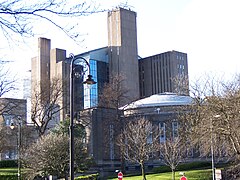Glasgow University Library

The Main Library Building with the McMillan Reading Room in the foreground.
|
|
| Country | Scotland |
|---|---|
| Type | Academic library |
| Established | 1475 |
| Location | University of Glasgow |
| Coordinates | 55°52′24″N 4°17′20″W / 55.8733°N 4.2890°WCoordinates: 55°52′24″N 4°17′20″W / 55.8733°N 4.2890°W |
| Branches | 8 |
| Collection | |
| Items collected | Books, manuscripts, journals and electronic resources |
| Size | 2.5 million physical volumes across all campus libraries, (4.3 million including e-books). |
| Legal deposit | Formerly (1709-1836) |
| Access and use | |
| Access requirements | Staff, students and alumni of the University of Glasgow |
| Other information | |
| Staff | 334 |
| Website | www.lib.gla.ac.uk |
The University of Glasgow Library in Scotland is one of the oldest and largest university libraries in Europe. At the turn of the 21st century, the main library building itself held 1,347,000 catalogued print books, and 53,300 journals. In total, the university library system including branch libraries now holds approximately 2.5 million books and journals, along with access to 1,853,000 e-books, and over 50,000 e-journals. The University also holds extensive archival material in a separate building. This includes the Scottish Business Archive, which alone amounts to 6.2 kilometers of manuscripts.
The current 12-storey building, opened in 1968, is a prominent landmark in Glasgow's West End and its distinctive outline can be seen from several kilometers around. In 2014, there were over 1.7 million visits made to the library.
The first explicit mention of the Library is dated November 1475, when the first donations by the University's Chancellor, Bishop John Laing, were recorded. After the Reformation the University of Glasgow and its Library were reinvigorated under the Principalship of Andrew Melville in 1574-80. The Library grew steadily throughout the 18th century due largely to the fact that it was granted legal deposit status between 1709 and 1836. Legal deposit ceased in 1836 and the Library was granted an annual lump sum which allowed it to develop its collections in line with the University's teaching and research interests. The library of the royal physician to Queen Charlotte, William Hunter, received in 1807, comprised some 10,000 volumes that augmented the library's holdings by fifty percent, and extended their reach well beyond the contemporary curriculum; of Hunter's 650 manuscript codices, over a hundred are illuminated, and his incunabula "accorded Glasgow a prominence that it could not have achieved with its own resources".
By 1888 the holdings of the Library had risen to around 150,000 volumes, due in part to large donations and contributions by wealthy private collectors, such as William Hunter, John Smith of Crutherland, George Walker-Arnott, William Euing and David Murray.
...
Wikipedia
